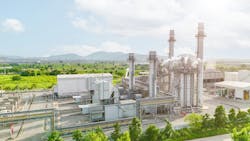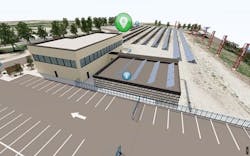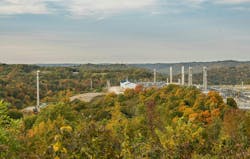On (Site) and Off (Grid): Industrial Electrification Future May Avoid Utility Interconnections
Grid-connected electricity proved to be the accelerator of economic growth throughout the 20th century. The utilities built the massive generators, transmission and distribution lines that fueled the engine carrying the U.S. to long-term prosperity.
Sometimes a good thing can lead to too much of a good thing. The complicated, often confusing maze of regulatory procedures and interconnection delays has pushed the completion of many new projects back two to four years, if not cause them to be abandoned because of uncertain timing.
The new century’s expansion in renewable energy capacity also helped back up the interconnection queue so much that delay time has nearly doubled with more than half of requested projects being withdrawn, according to a new report by the Lawrence Berkeley National Laboratory.
On-site and off-grid power, sometimes classified as behind-the-meter, is not new for remote customers, both residential and industrial. It is unusual to be built in the middle of the utility grid infrastructure but may become more common due to future project challenges.
The current and anticipated growth of load demand from new data centers is propelling the notion of massive behind-the-meter projects to meet future load necessitated by the growth of artificial intelligence (AI) training models, cloud-based hyperscale data capacity, industrial electrification and electric vehicle charging stations.
Repurposing conventional power in next-gen ways
“On and off” may sound ominous to economic planning but may generate a new trend in project development because of long queues and electrification demands
One way to get around the logjam of interconnection might be to build islanded microgrids and other on-site power plants to fuel the electricity needs of data centers. Companies such as Chevron and ExxonMobil are exploring this potential pathway for natural gas-fired power plants dedicated to data centers, while tech companies are looking for more carbon-free options and are pursuing contracts with small modular reactor (SMR) nuclear developers.
This may deliver a whole new market, gas-fired and yet off the grid, for producers and pipeliners.
“The behind-the-meter solution offers the companies separation from utility timelines and potentially accelerates installation pace that, perhaps, other alternatives cannot match,” Jeffrey Jen, senior associate and energy analyst at Enverus Intelligence Research, told the Oil & Gas Journal (OGJ) as quoted in OGJ’s ReEnterprised podcast with Managing Editor Mikaila Adams.
Indeed, DC Grid founder Vic Shao, himself a longtime entrepreneur who developed and eventually sold other companies doing direct current (DC) and off-grid EV charging infrastructure installations, believes that microgrid, off-grid and other decentralized or distributed energy systems will be a vital way forward and around a 20th century grid unprepared for the pace of 21st century digitalization, reshoring of manufacturing and heightened electrification of the commercial and industrial sectors.
“I’m convinced, whether it’s microgrid or off-grid or a DC grid, that these solutions are necessary,” Shao told EnergyTech.com in a 2024 interview. “There is a demand out there that utilities are not solving for.”
Only a few months later, DC Grid announced it was partnering with Liberty Energy on future projects tailored to commercial customers such as fleet electrification and data centers. The memorandum of understanding between the two companies is centered around developing direct-current power infrastructure which can support large-scale customers independent of the main grid.
"A reliable and robust energy supply is essential to drive economic growth, support ready-to-deploy cleantech innovations, and sustain critical advancements in AI (artificial intelligence)," Shao said when announcing the new partnership. "Our partnership with Liberty provides us with the opportunity to offer customers fast and reliable options for power. This is especially useful for data centers and fleet EV hubs that are in long queues for service upgrades from the local utilities.”
21st century technology needs immediate solutions
Many of those future off-grid and on-site power projects may certainly incorporate renewable wind, solar and battery storage but also meet baseload needs by tying into another carbon-free resource in currently operational nuclear power plants. Amazon Web Services (AWS) signed a deal with Talen Energy for direct connection to the Susquehanna Nuclear Station, while Microsoft signed a long-term power purchase agreement with Constellation that could fund reopening of the closed Three Mile Island Unit 1 within a few years.
Those are solutions, but not simple or speedy ones. Those nuclear agreements are also problematic, both financially and legally. The Susquehanna deal has faced U.S. Federal Energy Regulatory scrutiny, as well as challenges from utilities about the expense of transmission investment to support one customer, AWS.
And although SMR nuclear and future fusion projects may prove enticing, the truth is that no small reactor plant has yet been built for commercial operations and likely won’t be until the early 2030s. Expansion of nuclear energy may be inevitable because of data center load projections and the need for reducing greenhouse gas emissions, but getting there will take most of the coming decade and untold billions of dollars in investment.
Natural gas, meanwhile, is abundant now and cleaner, at least on some environmental levels, than coal-fired power generation. Gross gas production in November 2024 alone topped 3.7 trillion cubic feet, nearly double the same month in 1980, according to the federal Energy Information Administration.
The volume of proved reserves, or natural gas not yet produced to surface but confirmed in shale plays and other reservoirs, has grown more than three-fold over the past 40 years to more than 700 trillion cubic feet, or the equivalent of more than 30 years of current U.S. consumption levels, according to the EIA’s most recent figures.
So, while net-zero remains the announced goal of many companies, the known demands of AI and industrial electrification require more baseload and fossil power than renewables can deliver or SMR nuclear can promise right now. Many could turn toward on-site natural gas power because it’s affordable, available and, well, it’s not coal.
To get those projects completed on time to suit customers such as data centers, those microgrids and power plants might be built at a scale rarely imagined only a few years ago. To hurdle or avoid layers of utility interconnection and regulatory delays, they may also be built on-site and off-grid.
Get the Full Story on Microgrids and Re-Industrialization
Attend the Microgrid Knowledge Conference in Dallas this April
About the Author
Rod Walton, Microgrid Knowledge Managing Editor
Managing Editor
For Microgrid Knowledge editorial inquiries, please contact Managing Editor Rod Walton at [email protected].
I’ve spent the last 15 years covering the energy industry as a newspaper and trade journalist. I was an energy writer and business editor at the Tulsa World before moving to business-to-business media at PennWell Publishing, which later became Clarion Events, where I covered the electric power industry. I joined Endeavor Business Media in November 2021 to help launch EnergyTech, one of the company’s newest media brands. I joined Microgrid Knowledge in July 2023.
I earned my Bachelors degree in journalism from the University of Oklahoma. My career stops include the Moore American, Bartlesville Examiner-Enterprise, Wagoner Tribune and Tulsa World, all in Oklahoma . I have been married to Laura for the past 33-plus years and we have four children and one adorable granddaughter. We want the energy transition to make their lives better in the future.
Microgrid Knowledge and EnergyTech are focused on the mission critical and large-scale energy users and their sustainability and resiliency goals. These include the commercial and industrial sectors, as well as the military, universities, data centers and microgrids. The C&I sectors together account for close to 30 percent of greenhouse gas emissions in the U.S.
Many large-scale energy users such as Fortune 500 companies, and mission-critical users such as military bases, universities, healthcare facilities, public safety and data centers, shifting their energy priorities to reach net-zero carbon goals within the coming decades. These include plans for renewable energy power purchase agreements, but also on-site resiliency projects such as microgrids, combined heat and power, rooftop solar, energy storage, digitalization and building efficiency upgrades.



